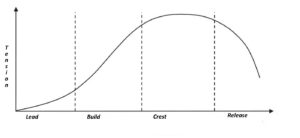Go ahead: stop reading this right now and make a list of your personal top ten songs of all time. Most of us can name and remember more than ten, so this will be easy. Write them down – no need to rank them, just make the list, but number the songs one to ten for ease of use. Do that now. You’re about to discover a new approach to what your top ten songs say about you.
Ready?
For this reveal, it doesn’t matter whether or not your top ten songs have words because it’s all about how your songs make you feel. Words can be a part of that, or not. It’s all good. What you’re about to learn is all about “how” music works on you, not “what” music is.
The “how” of your songs takes place below the level of conscious thought. When the consciousness is quiet, subconscious awareness – maybe you call it mindfulness, but it’s more intuitive than that – is the place where you can learn what your top ten songs say about you.
That kind of awareness is easy to approach through music, and with some practice, you can go there reliably. Music offers you a safe, durable pathway to this kind of self-awareness and emotional integrity. If this is new for you, please don’t stress: you have complete control since, after all, this is your top ten list.
Where are you on the Wheel?
An expert influencer named Robert Plutchick offered the world a 3D version of what he called the Wheel of Emotions in the early 1980s. Imagine the nearby 2D version as a cone; it’s a little easier to grok in two dimensions. The colors and placement of the primary emotions around the Wheel are intentional.

To learn what your top ten songs say about you, create a personal plot of the emotional content of your top ten songs on the Wheel. You can do that in any way that’s easiest for you. If a larger, printable version of the Wheel would help, you can download one at this link.
Here’s what to do: to keep it simple, just number your top ten songs – order isn’t important – and write the number of each song from your list on the Wheel in a position that comes closest to what you feel when you listen to the song.
Yes: some songs may make you feel more than one way! If there’s no predominant emotion, just write the number of the song in more than one place on the Wheel. There’s no right or wrong answer; these are your songs and your feelings.
Here’s where emotional integrity comes in.
Emotional integrity
The music we love is the most powerful music for us, according to research, so your top ten songs are your power songs. They connect deeply with your subconscious self. Most of us formed our musical preferences during adolescence and early adulthood – the crucial years that shape and inform our adult selves. The music we love still connects us deeply to those formative years. Even if our “core” musical preferences have changed over our lifetimes, we still retain strong memories of the music from earlier in our lives, and those historical likes and dislikes still influence what we most enjoy, musically speaking.
In many ways, “your” songs are the songs that still echo your subconscious needs and desires from that formative era of your life. These songs also point to a kind of whole-being preference you have – they resonate deeply with your emotional core.

A big part of emotional integrity is judgment neutrality. That is, if we look at emotions without regard for whether or not we like them or want them, emotions become more like guardrails that help us stay centered along the road of life. Emotional judgment-neutrality is hard work, especially if one’s belief system is biased towards positive emotions, but if we remember that emotions are simply indicators of potential responses this can free us up to experience the emotion without a need to express it in action or judge it in some way.
Music is a great way to practice that skill: hearing music that triggers emotions we don’t like or want gives us the opportunity to experience the emotion without a need to act out on it or judge ourselves for feeling it. Like all emotions, even the ones we enjoy and want come and go, just like the internal chemical reactions that they are.
That’s an important paragraph. To summarize it: emotional integrity is the authentic experience of all emotions with neither judgment about them or a need to act them out.
Now let’s see how you’ve mapped out your top ten songs’ emotional content on the Wheel. There are two basic ways most of us plot our top ten songs on the Wheel: clustered or distributed.
The cluster pattern
If you find that your songs are all clustered in one section of the Wheel, what does that say about you? If the cluster is towards the edge of the Wheel, the emotional energy isn’t as intense as toward the center. The approximate “center” of the cluster is also the emotional center you have chosen for yourself.
The self-awareness that a cluster offers you – indicated by the fact that your top ten songs all hold similar emotional content for you – is that your preference is for a particular, somewhat narrow range of emotions in music. This preference could have very deep roots.
For example, do your subconscious emotional preferences extend to emotional preferences in your conscious life as well? Do you prefer experiences, friends, tasks, or thoughts that align with this primary emotional preference? Do you feel that the essential core of your being aligns deeply with the emotional content of your top ten songs? If you answered yes, why do you think that is?
On the other hand, some of us have a musical preference that we believe helps us steer away from emotions we don’t like or don’t want to experience. If you are aware that you do this with music, its emotional integrity demands that you ask yourself why you choose to avoid particular musical emotions. Psychology postulates (and research tends to prove) that damage can result when we stuff or suppress emotions we don’t want to experience. Not good.
A cluster example using joy

Let’s take an example. Suppose that your songs all cluster around the quadrant of the Wheel that contains joy. What a great way to be! But why? When you formed your musical preferences, did they flow from a deeply-embodied sense of contentment, peace, and happiness? Or were they a way of trying to find elusive joy by using joyful music to drown out other feelings you didn’t want? This is important self-knowledge to have or gain, since others – especially those who care about you! – are curious about your emotional well-being and often want to help you regain it if they notice you are in distress.
So far, in this example about joy, whether you are just coming awake to your own understanding of emotions or are already a seasoned traveler of the emotional journey, your musical emotional map indicates one of these two things:
- You are an authentic, emotionally honest lover of joyful music,
or
- You have built a musical habit of avoiding feeling anything but joy.
To be judgment-neutral and emotionally integrated with joy, it’s important to understand that joy, as good as it feels and like all the other emotions on the Wheel, is just another one of the human feelings we “do.” One could make the same accurate observations about a cluster pattern of anger, fear, or sadness. Regardless of the predominant emotion in your top ten songs, if those songs all fall into one of these broad categories, the plot of their emotions on the Wheel is a cluster.
Whatever the emotional center of your particular cluster may be, you have chosen music that aligns deeply with your emotional preferences. And please: no judgment about whether your preferences are “good” or not!
In my own life, I experienced chronic melancholy in my formative years, so I had plenty of music that went well with that. Even though this may not seem very “good” to you, emotional integrity helped me own this fact about myself. It also opened the central pathway in my life for self-awareness and progress toward a more balanced emotional experience. I’ve had to observe, recognize, and welcome the other emotional experiences on the Wheel – such as joy and music that supports joy! – to fully realize my potential, and so can you.
The distributed pattern
Unlike clusters, when your top ten songs seem to hit several parts of the Wheel, what does this say about you?
It takes integrity to own emotions we don’t want or don’t like. There’s been a historical tendency to allow emotions to define us: Bill’s always melancholy, for example. Or, worse, Bill’s chronically depressed. But how honest is that? It can take time and effort to even become familiar with emotions that are new to us, or perhaps were tactfully eliminated from our childhoods by well-meaning caregivers, or were permitted but only within strict parameters. My emotional range in childhood was quite a bit narrower than it is today, and I’ve really had to work to gain emotional fluency with the feelings that were most unfamiliar.

Fortunately, music has helped. With Classical piano music, my job is to master A) the technical details of re-creating the notes and B) the authentic communication of the emotional content of the music (through timbre, phrasing, dynamics, and tempo, for example). I got pretty good at that at an early age, but when I wasn’t at the piano, I couldn’t express authentic emotion very well! I had to intentionally learn how things felt to me, and when I began to do that, everything changed.
If you were to plot my top ten songs on the Wheel, they would be quite distributed. These days, I have at least a couple of songs for each of the four primary emotions (joy, sadness, anger, and fear). I’ve come to recognize that emotional integrity means experiencing all the feels, and that I can make a conscious choice about my response that’s much more powerful if I don’t choose to ignore some of the emotional information available to me just because I don’t “like” it.
What about your top ten songs and the distributed plot of their emotions on the Wheel?
Generally, if your top ten songs hit all over the Wheel, this shows that you are achieving a level of emotional integrity. Like me, you may find that you have a predominant core of songs that resonate deeply – mine are in sadness – with a scattering of songs in other parts of the emotional Wheel that somehow feel right for you.
What can I do with this knowledge?
Whether your songs made a cluster pattern or a distributed one, the key take-away from this exercise is that you have opportunities for self-awareness that you may have not considered until now. That is, your musical preferences tend to reveal areas where important transformational work could be done, should you choose to do it:
- Cluster patterns can indicate an opportunity to significantly broaden one’s emotional range;
- Distributed patterns can indicate gaps in emotional integrity.
How you choose to do this work is up to you, but there is a growing trend toward what some call emotional intelligence (or emotional fluency or emotional agility) that is challenging all of us to find reliable ways to grow in this area.
Got empathy?
For example, it is completely impossible for a person who has experience in a given emotion – let’s say, sadness – to have empathy with someone else who’s unhappy. Can’t happen! Empathy implies that the empathizer has some emotional experience that’s similar to or mirrors the experience of the empathizee, doesn’t it, so how can a chronically happy person have authentic empathy for someone who’s sad?
If you believe you are “good” at empathy, query your emotional integrity and notice if your empathy extends to all quadrants of the Wheel. Can you empathize with someone who’s afraid, who’s angry, who’s sad, who’s joyous? If not, learn how those emotions feel before attempting to empathize. Please!
Empathy and the toxic boss
How can a perpetually angry manager offer subordinates any kind of authentic praise? The manager must acquire honest emotional fluency with praise before being able to give it authentically. What are the emotions in praise? The manager would need to have immediate access to those emotions and an ability to deploy them reliably with a spoken word or a handshake (for example) in order to have their praise received authentically.
If you need emotional depth, music is a great place to start. Most of the streaming music services today allow us to access songs by emotional mood, which is one way to start becoming fluent in emotions that aren’t currently in your emotional vocabulary. Take a look at your marked-up Wheel and identify the gaps. Find music to help you acquire emotional fluency in those gaps. Learn to bring those emotions into conscious contact with opportunities to use them. As you become more conversant in the language of emotions, you may also find yourself gradually finding new songs for your top ten list.
That’s a wrap
Thank you for taking this short journey with me. I hope you’ve been challenged in a new way to take a close look at your emotional preferences in the music you love, and that you’re on board with identifying gaps in your emotional fluency and filling them consciously. If you follow the suggestions in this article, you’ll have begun one of the most important and crucial endeavors in your life: coming to terms with your own authentic being.
Yes: we are far more than what we feel, and yet there is incredible power in emotional integrity. Whole nations have arisen from anger; fear has impelled individuals and societies to build infrastructure for safety and sustainability; sadness has opened opportunities for enlightenment; joy has offered respite. Master these four emotions, feel the power each one holds for you, and use your built-in superpowers wisely and for good.
Contact
To continue this conversation, ask questions, or just sound off, give me a call. My pubic calendar is here and I’d welcome a few minutes together to explore your response to this article and suggest ways you can begin this work, continue it, or turn it up to 11. Your choice!



